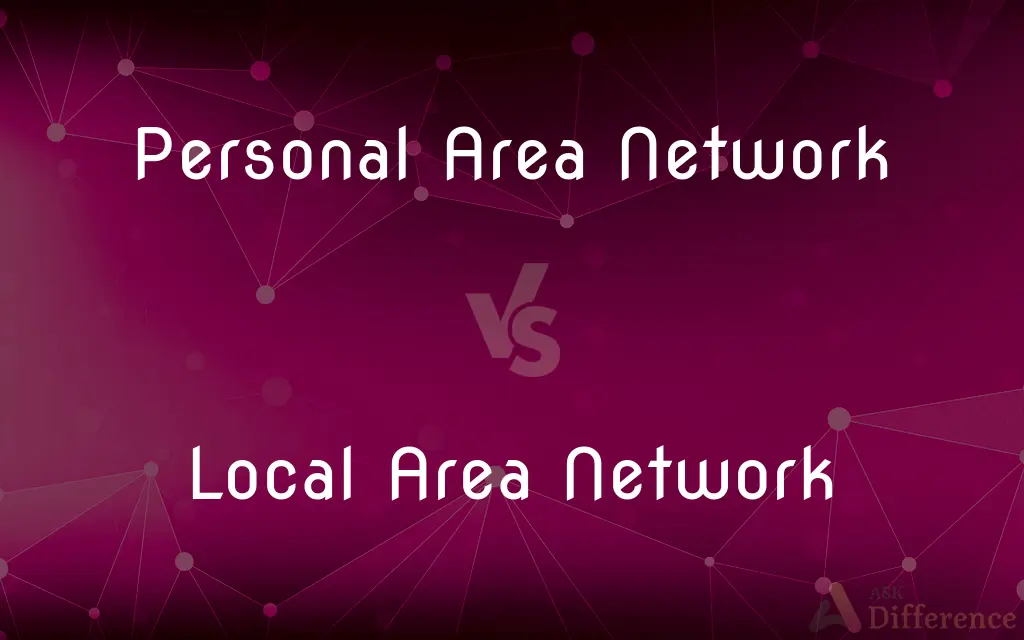Personal Area Network vs. Local Area Network — What's the Difference?
Edited by Tayyaba Rehman — By Fiza Rafique — Published on December 17, 2023
A Personal Area Network (PAN) is designed for individual device connectivity, often within a person's immediate vicinity, while a Local Area Network (LAN) connects devices within a localized, but broader area, like a building or campus.

Difference Between Personal Area Network and Local Area Network
Table of Contents
ADVERTISEMENT
Key Differences
A Personal Area Network (PAN) primarily serves the needs of an individual person, typically encompassing devices such as smartphones, tablets, and wearable tech. Conversely, a Local Area Network (LAN) is oriented towards a more extensive setting like an office or a building, enabling computers and other devices to share resources. PAN, due to its nature, covers a smaller physical area, often limited to one's body or a room. On the other hand, LAN, while still localized, spans a more considerable distance, such as across multiple floors of a building.
The technology foundation also differs between a Personal Area Network and a Local Area Network. PANs often rely on technologies like Bluetooth and USB, facilitating short-range connections. In contrast, LANs predominantly use Ethernet or Wi-Fi, enabling longer-range but still localized connectivity. While both PAN and LAN serve to connect multiple devices, the scale and scope of their connections vary considerably.
One might utilize a Personal Area Network to connect their headphones to a smartphone or to sync a smartwatch. Meanwhile, a Local Area Network would be apt for connecting computers in an office to shared printers or storage servers. Understanding the distinctions between PAN and LAN is essential when considering the connectivity needs and scale of a specific environment.
Comparison Chart
Primary Use
Individual device connectivity
Connects devices in a localized area
Typical Range
Immediate vicinity (body or room)
Building or campus
ADVERTISEMENT
Common Technologies
Bluetooth, USB
Ethernet, Wi-Fi
Example Devices
Smartphones, smartwatches, headphones
Computers, printers, servers
Scope
Designed for an individual's needs
Geared for office or building environment
Compare with Definitions
Personal Area Network
PAN focuses on short-range connections.
I connected my earbuds via Bluetooth on my Personal Area Network.
Local Area Network
Local Area Network primarily employs Ethernet and Wi-Fi connections.
To boost speed, we wired our computers using Ethernet in our Local Area Network.
Personal Area Network
A Personal Area Network connects devices close to an individual.
My smartwatch syncs data through my Personal Area Network.
Local Area Network
A Local Area Network connects devices within a specific locale.
The computers in our office are linked through a Local Area Network.
Personal Area Network
Personal Area Network encompasses connections like USB and Bluetooth.
Through my Personal Area Network, I transferred photos using a USB cable.
Local Area Network
LAN is designed for environments like offices or campuses.
We installed a Wi-Fi router to expand our Local Area Network.
Personal Area Network
A Personal Area Network prioritizes individual device interconnectivity.
I use a Personal Area Network to tether my tablet to my smartphone's internet.
Local Area Network
A Local Area Network lets devices share resources within a limited area.
Our printer is accessible to all computers on the Local Area Network.
Personal Area Network
PAN typically covers a very limited spatial range.
My wireless headphones connect to my phone within the radius of my Personal Area Network.
Local Area Network
LANs offer connectivity across larger areas than PANs but remain localized.
The entire university campus operates on a single Local Area Network.
Common Curiosities
What does a Personal Area Network primarily serve?
A Personal Area Network primarily serves individual device connectivity.
What technology is commonly used in LANs for connecting devices?
Ethernet and Wi-Fi are commonly used in Local Area Networks.
Which network type would be suitable for connecting wireless headphones to a phone?
A Personal Area Network would be suitable.
Can a PAN connect devices across multiple rooms?
Typically, a PAN is best for immediate vicinity connections, often within a single room.
Can a PAN be used to transfer files between a computer and a smartphone?
Yes, a Personal Area Network can be used for such short-range transfers, often via Bluetooth or USB.
How does the range of a Local Area Network compare to that of a PAN?
A Local Area Network covers a broader area, like a building, while a PAN is more immediate, often just around a person.
What is the most common technology underpinning PANs?
Bluetooth is a widespread technology for Personal Area Networks.
Can a Local Area Network span multiple buildings?
Yes, a Local Area Network can span multiple buildings, especially on campuses.
How are data speeds in a LAN typically?
Data speeds in a Local Area Network are often fast and consistent, especially with wired connections.
Which is more expansive in terms of geographic coverage: Personal Area Network or Local Area Network?
Local Area Network typically covers a more expansive geographic area than a Personal Area Network.
What's a common use of a LAN in businesses?
Businesses often use a Local Area Network to connect office computers and share resources.
How do range and purpose of a PAN and LAN differ?
A PAN has a shorter range for individual devices, while a LAN covers broader areas, such as buildings, for device interconnectivity.
Are Wi-Fi connections exclusive to LANs?
No, while Wi-Fi is common in LANs, some PAN technologies also use Wi-Fi, like Wi-Fi Direct.
Which network is best for connecting a smartwatch to a phone?
A Personal Area Network is best suited for such connections.
Is internet access mandatory for a PAN or LAN to operate?
No, both PAN and LAN can operate locally without internet access, though many setups use them to access the internet.
Share Your Discovery

Previous Comparison
Excitation Potential vs. Ionization Potential
Next Comparison
Calcium Chloride vs. Calcium Chloride DihydrateAuthor Spotlight
Written by
Fiza RafiqueFiza Rafique is a skilled content writer at AskDifference.com, where she meticulously refines and enhances written pieces. Drawing from her vast editorial expertise, Fiza ensures clarity, accuracy, and precision in every article. Passionate about language, she continually seeks to elevate the quality of content for readers worldwide.
Edited by
Tayyaba RehmanTayyaba Rehman is a distinguished writer, currently serving as a primary contributor to askdifference.com. As a researcher in semantics and etymology, Tayyaba's passion for the complexity of languages and their distinctions has found a perfect home on the platform. Tayyaba delves into the intricacies of language, distinguishing between commonly confused words and phrases, thereby providing clarity for readers worldwide.
















































